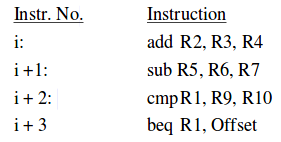GATE-CS-2017 (Set 1)
Question 41
Consider a RISC machine where each instruction is exactly 4 bytes long. Conditional and unconditional branch instructions use PC- relative addressing mode with Offset specified in bytes to the target location of the branch instruction. Further the Offset is always with respect to the address of the next instruction in the program sequence. Consider the following instruction sequence 
If the target of the branch instruction is i, then the decimal value of the Offset is __________.
Note: This questions appeared as Numerical Answer Type.
Question 42
G1: S-->aSb|T T--> cT|∈ G2: S-->bSa|T T--> cT|∈The language L1(G1) ∩ L2(G2).
Question 43
S → SaS | aSb | bSa | SS | ∈where S is the start variable, then which one of the following is not generated by G?
Question 44
Note: This questions appeared as Numerical Answer Type.
Question 45
Let A be m×n real valued square symmetric matrix of rank 2 with expression given below.
Consider the following statements
(i) One eigenvalue must be in [-5, 5].
(ii) The eigenvalue with the largest magnitude
must be strictly greater than 5.
Which of the above statements about eigenvalues of A is/are necessarily CORRECT?
Question 46
if TS(T2) <TS(T1) then
T1 is killed
else T2 waits.
Assume any transactions that is not killed terminates eventually. Which of the following is TRUE about the database system that uses the above algorithm to prevent deadlocks?
Question 47
Bit rate of the transmission channel = 1MbpsAssume that there are no transmission errors. Then the transmission efficiency ( expressed in percentage) of the Stop-and – Wait ARQ protocol for the above parameters is _________( correct to 2 decimal place) .
Propagation delay from sender to receiver = 0.75 ms
Time to process a frame = 0.25ms
Number of bytes in the information frame = 1980
Number of bytes in the acknowledge frame = 20
Number of overhead bytes in the information frame = 20
Note: This questions appeared as Numerical Answer Type.
Question 49
void fun1(int n){
if(n == 0) return;
printf(“%d”, n);
fun2(n-2);
printf(“%d”, n);
}
void fun2(int n){
if(n == 0) return;
printf(“%d”, n);
fun1(++n);
printf(“%d”, n);
}
The output printed when fun1 (5) is called is
Question 50
(0,128,256,128,0,128,256,128,1,129,257,129,1,129,257,129)is repeated 10 times. The number of conflict misses experienced by the cache is ___________.
Note: This questions appeared as Numerical Answer Type.
There are 65 questions to complete.
